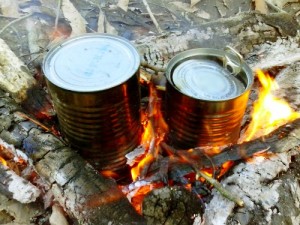 Primitive baking often uses mud as a heat buffer and defuses the heat more evenly. My article “Mud Spuds” describes the simplicity of this method. But for folks who aren’t inclined to use mud, you can use a modern alternative: a tin can. The goal of baking is to achieve even heat to cook your food more thoroughly and preferably without charring. If you are out camping and have brought some provisions, you can save the tin cans from your beans or soup for this purpose and keep the lids as well.
Primitive baking often uses mud as a heat buffer and defuses the heat more evenly. My article “Mud Spuds” describes the simplicity of this method. But for folks who aren’t inclined to use mud, you can use a modern alternative: a tin can. The goal of baking is to achieve even heat to cook your food more thoroughly and preferably without charring. If you are out camping and have brought some provisions, you can save the tin cans from your beans or soup for this purpose and keep the lids as well.
I decided to give this “can baking” a try and tested two methods: a single can using it’s lid as a cover, and a double can arrangement with a larger can inverted over a smaller can. I favor cans with pull-tab tops that require no tools to open and also provides a “handle” for managing the lids. This works well with the single can method. However, in my double can set-up I used a P38 can opener to remove the lids on both cans which allowed the second slightly larger pull-tab can to be used as a cover over a conventional can. I put two medium sized potatoes in each can set-up.
The best results for baking will come from the radiant heat of coals. I built a campfire and let it burn down to establish coals, then cleared a spot in the middle and placed the cans in the center. I fed small kindling around the edges to keep the coals alive and minimize the smoke. Slower cooking temps with a longer cooking time will penetrate the food deeper for more even cooking. I also turned the cans occasionally to help promote even heat. As usual, cooking times will vary based on heat source, can set-ups and the mass of the objects being baked. In the end, the double can potatoes took 35 minutes to bake to perfection while the single can took an additional 5 minutes due to the less efficient heat containment.
So next time you have tin cans and a campfire, experiment with them for baking different foods and become familiar with this baking method.



Please be cautious when you choose your can. Some of them are lined now with a plastic film. You do not want melted plastic in your food. I check for the film before I cook my vegetables over the open fire too.
I was cooking like this in the mid-1980s. I was in the USAF and out in a Defensive Fighting Position (foxhole). It was below freezing and not only did this make great hot meals, but it also kept us warm.